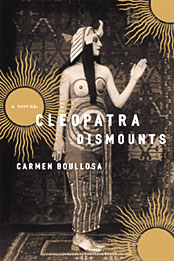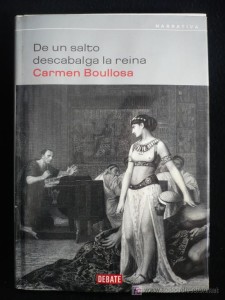
De un salto descabalga la reina
(Cleopatra Dismounts)
Publisher’s description:
Carmen Boullosa is one of Latin America’s most original voices, and in Cleopatra Dismounts she has written a remarkable novel of one of history’s most legendary women.
Cleopatra Dismounts is an imagined reconstruction of the life of the Egyptian queen, called Queen of Kings by her subjects and widely said to be the incarnation of the goddess Isis. In the opening section, dying in Marc Antony’s arms, Cleopatra bewails the ignominious end to her larger-than-life career through the political world of ancient Egypt, Greece, and the Mediterranean. But is this really the true Cleopatra?
Through the intervention of Cleopatra’s scribe and informer Diomedes, Boullosa creates two previous Cleopatras, and in effect two deliriously wild other lives for the young monarch-a girl escaping the intrigues of royal society, fleeing in the back of a horse cart to Ascalon, to disguise herself and take up residence with a band of pirates; and the young queen who is carried across the sea on the back of a magical bull, to live among the Amazons and become part of their society, learning their battle techniques and stories of love.
Magical, multifaceted, and rippling with luminous imagination, Cleopatra Dismounts confirms Carmen Boullosa as an important international voice.
De un salto descabalga la reina, Editorial Debate, Madrid, 2000.
Cleopatra Dismounts, trans. Geoff Hargreaves, Grove Press, New York, 2002.
Excerpts from reviews:
Beyond Elizabeth Taylor – Women’s Review of Books (PDF)
Queen of Hearts; A rousing fictional account of the ancient monarch’s life and loves – Washington Post (PDF)
Lisa Nussbaum:
In this enchanting work, Mexican author Boullosa (They’re Cows, We’re Pigs) retells Cleopatra’s story three times over. In Part 1, the queen clings to the lifeless (and disemboweled) body of her beloved Marc Antony, considering how her love brought out her nobler qualities while greatly enhancing her reputation, riches, and political power. Part 2 shows her rising above the palace intrigue and testing her mettle by joining a band of pirates. In Part 3, a magical bull transports the fearless queen across the Mediterranean Sea to the home of the Amazons. Although told in the first person, these tales come from the pen of Cleopatra’s scribe, whose presence adds more intrigue as his credibility is questioned again and again. What results is a remarkable homage to a remarkable woman who, in the words of Boullosa, chooses to be “unfaithful to her nature.” Rich, inventive, evocative, erotic, and even bawdy in places, Boullosa’s writing is not for the fainthearted, but readers who try it will be rewarded. Highly recommended for medium and large academic and public libraries.
Library Journal
An imaginative retelling of the life and death of the Egyptian femme fatale, by Mexican poet, playwright, and novelist Boullosa. The parts of this tale that stick to the history-real or imagined-of ancient Rome and Egypt are lively, intriguing, and well-wrought in every detail; but when Boullosa ventures into the netherworlds of the Amazons and all the rest her story acquires a Munchausen-like absurdity
Kirkus Reviews
Mexican writer Boullosa (Leaving Tabasco, etc.) lavishly reimagines the life of the legendary Cleopatra of Egypt in this daring intermingling of fantasy and history told in various voices.
Publishers Weekly
Excerpt | Press | Buy the book | Isidore of Seville

